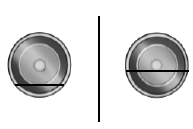Driving through water
WARNING: Drive through water in an emergency only, and not as part of normal driving.
WARNING: Engine damage can occur if water enters the air filter.
Note: Driving through deep water may allow water into the transmission or air intake and can cause internal vehicle damage or cause it to stall.
Note: Once through the water, always dry the brakes by moving your vehicle slowly while applying light pressure on the brake pedal.
If driving through deep or standing water is unavoidable, proceed very slowly. Never drive through water that is higher than the bottom of the wheel rims (for cars) or the bottom of the hubs (for trucks).

When driving through water, traction or brake capability may be limited. Also, water may enter your engine’s air intake and severely damage your engine or your vehicle may stall.
Wet brakes do not stop the vehicle as quickly as dry brakes.
See also:
Rain-sensing wipers
Note: Wet road conditions may result in inconsistent or unexpected wiping
or smearing. Lower the sensitivity, switch to normal or high-speed wiping or turn
the wipers off to reduce smearing.
Note ...
Overhead console (if equipped)
The appearance of your vehicle’s overhead console will vary according to your
option package.
Storage compartment (if equipped)
Press the release on the door to open the storage compartment.
Th ...
Normal scheduled maintenance and log
Intelligent Oil-Life Monitor®
Your vehicle is equipped with an Intelligent Oil-Life Monitor® that determines
when the engine oil needs to be changed based on how your vehicle is used. By using
...
